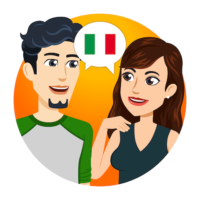When it comes to learning Italian — or any language for that matter! — there are some important aspects that you really can’t avoid. Memorizing the most useful words and phrases, practicing comprehension with movies, TV series, and podcasts, and of course, learning to communicate. Whether your goal is to meet native Italian speakers, learn the basics (fast) for an upcoming trip to Italy, or dig into Italian culture, you’re going to have to learn to speak Italian.
In this article, we look at some of the best resources for learning Italian, especially as they relate to spoken Italian.

Why Practice Speaking Italian?
Did you know that there are many different regional dialects in Italy? They include Neapolitan, Sicilian, and Piedmontese, although Tuscan is the most widely spoken. Italian is spoken as a first language by 68 million people, and by 17 million others as a second language, for a grand total of 85 million Italian speakers.* So, how about you? Is your spoken Italian improving?
Learning to speak Italian is a little like learning to play the guitar. You can read about it, study chord and fingering charts, and watch videos — but if you don’t practice, you won’t get very far. Only by practicing your spoken Italian can you expect to reach an advanced (or even a conversational) level.
If you’re learning Italian to be able to travel freely in Italy and talk to the locals, order at a restaurant, book a hotel room (or another one of these 5 great reasons to learn Italian) you’re going to have to practice speaking Italian. But don’t worry, you don’t need to buy a plane ticket to get started!
You can start practicing your spoken Italian from the comfort of home, just follow these tips.
Tips and Exercises to Learn to Speak Italian
-
Don’t forget about pronunciation
Like all good language learners, you’ve probably started by focusing on the alphabet and learning vocabulary, hopefully with the words and phrases that are most commonly used in Italian. That’s a good place to start, but if you want to speak Italian like Kobe Bryant, it’s also absolutely essential that, while you’re learning vocabulary, you learn pronunciation at the same time.
Don’t try to pronounce Italian words with your native English accent. This won’t work out well. Instead, it’s important to start practicing your Italian accent as soon as possible.
How?
If you use our app, listen to the recordings by native Italian speakers that accompany all of our vocabulary.
You can also use the International Phonetic Alphabet for a more technical way to check the pronunciation of Italian words. It’s a bit complicated at first, but a powerful tool once you get the hang of it. Another option is an online translator like Google Translate, though the voice is artificial. Pronunciation websites like Forvo, which run on audio contributions from native speakers, are another good alternative, although the quality may not be as good as your MosaLingua app.
Whenever you learn a new word, remember to listen carefully to its pronunciation, and to repeat it out loud several times. Don’t be shy! This is the best way to begin practicing your pronunciation: say your new words loudly and clearly. Rather than reading them in your head, this allows you to get used to the pronunciation and compare it to local speakers.
We’re also working on an Italian pronunciation guide, but in the meantime, we have a few articles and videos to get you started. English speakers tend to have a hard time with the rolled R in Italian, so we recommend working on that first.
-
Try the self-talk and shadowing techniques
Listening to the right pronunciation is one thing, but you’ll need to start practicing groups of words and full sentences if you really want to learn to speak Italian. There are two great techniques for this:
- The Self-Talk Technique. This is just what it sounds like: talking with yourself! If you’d like to start learning to express yourself in Italian but don’t have anybody to practice with, don’t worry. You can very easily play both sides of a conversation. Don’t worry about feeling silly — you’re all alone, and it’s a perfectly valid way to improve your speech! You’ll be surprised by how quickly you can make progress just through the act of speaking your way through a typical conversation. Start with a simple Buongiorno and go from there. Talk about your day, your challenges, your hopes and dreams, your favorite food, whatever you like. Learn more about self-talk or self-conversation here.
- The Shadowing Technique. This technique consists of repeating what you hear in Italian movies, TV series, podcasts, and more. Watching films and TV series is a great way to immerse yourself in a language. For the shadowing technique, try to find an actor or character who has an Italian accent you like, and start repeating what they say. Feel free to pause your movie or podcast to repeat what you hear. Also, did you know that singing can be a fun way to work on Italian pronunciation? We especially like these songs by Andrea Bocelli. Learn more about the shadowing technique here.
In both cases, record yourself so that you can compare it to native speakers, either from movies and TV shows or somebody you know. These are two great techniques to learn to speak Italian for free.
-
Dive in! Practice with native speakers
This is without a doubt the best way to practice speaking Italian. But you may be wondering where and how to meet native speakers without leaving the country.
One of the best ways is to use a language exchange website. Just remember that there are plenty of Italian locals out there who are trying to learn English. Language exchange sites allow two or more people to connect and spend some time speaking in each language. It’s a fantastic way to meet new people who share your interest in learning a new language, and a great way to dramatically improve your spoken Italian.
Making the most of language learning sites
Focus on finding an Italian speaker who has about the same level of English as your Italian, or just a little above it. This allows for a more enjoyable and equal experience, as you’ll have the same needs and can learn and practice together. You also don’t have to feel nervous about making mistakes. You’re both in the same situation, working together to get better. The more mistakes you make, the more your partner will be able to help you, and vice versa.
It’s a good idea to write down your mistakes and the correction in a notebook, as well. Otherwise, you can ask your language partner to make a note of your mistakes, and discuss them at the end. Of course, you’ll also be expected to do the same thing for your partner.
Finally, no matter how you split up your time, just make sure it’s equal. They’re taking the time to teach you Italian, so be sure you spend an equal amount of time speaking in English. You can divide your time up into different 10-minute sections, or else do all Italian for half an hour and then all English for the remaining thirty minutes. It’s up to you, just remember to keep it fair.
This is one of the best ways to make fantastic progress learning to speak Italian. Not only do you get to practice your pronunciation and accent out loud, and listen to a native speaker, but they’ll help you track down your errors and provide you with advice as needed.
-
Speak Italian often
Consistency is key. Practicing once in a while won’t help you make any real progress. The more you practice speaking, and the more frequently you repeat and practice new words, the better you’ll learn them. Make a point of practicing every day, even if it’s just for 15 or 20 minutes. Self-conversation, shadowing, and talking with a conversation partner are all great ways to learn to speak Italian, but you need to do them regularly. Practice as often as you can, and you’ll be amazed at how quickly and easily you learn to speak Italian!
MosaLingua Can Help You Speak Italian Better
To help you improve your spoken Italian, we created the Speak Italian with Confidence masterclass. The program is designed to help you improve your pronunciation, fluency, and confidence in Italian. It’s divided into 8 modules and includes step-by-step instructions, lessons and videos for technique, and plenty of fun exercises.
A few final words
We hope you’ll find these tips and techniques useful. To take your studies a step further, here are some more articles about learning Italian that may interest you:
- 8 tips for learning Italian online
- The best YouTube channels for learning Italian
- And here’s why Italian grammar is easy (yes, really!)
*Lewis, M. Paul (ed.), 2009. Ethnologue: Languages of the World, 16th edition. Dallas, Texas: SIL International.
Related posts:
Improve your spoken Italian

Good news: we have a course for that! The Speak Italian with Confidence MasterClass.
It’s a comprehensive 8-module course designed to help you improve every aspect of your spoken Italian – fluency, confidence, pronunciation, and more – step by step, and enjoy doing it.






Comments